Analysis of the Driving Altitude and Ambient Temperature Impact on the Conversion Efficiency of Oxidation Catalysts
Abstract
:1. Introduction
2. Material and Methods
2.1. Experimental Setup
2.2. Catalyst Model
2.3. Test and Modeling Procedure
3. Discussion of the Results
3.1. CO and HC Conversion Efficiency
3.2. Role of Flow Properties in Conversion Efficiency Variation
3.3. Light-Off Curves Sensitivity Analysis
- The black series corresponds to the baseline warm sea-level case, i.e., experimental dwell time and gas composition at 0 m and 20 °C.
- As a first step, the dark gray series represents the results of a simulation where the warm sea-level setup was modified, imposing the dwell time that corresponds to cold altitude.
- Next, the light gray series was obtained from warm sea-level case, but imposing both the dwell time and O2 partial pressure of the cold altitude case.
- Finally, the red series corresponds to the baseline cold altitude, i.e., dwell time, O2 partial pressure, and pollutants partial pressure (kinetic term and inhibition) impact with respect to warm sea-level results.
4. Summary and Conclusions
Author Contributions
Funding
Conflicts of Interest
Abbreviations
| Acronyms | |
| ATS | aftertreatment system |
| DOC | diesel oxidation catalyst |
| EGR | exhaust gas recirculation |
| HP-EGR | high pressure EGR |
| HSDI | high-speed direct injection |
| LP-EGR | low pressure EGR |
| MEDAS | multifunctional efficient dynamic altitude simulator |
| MTM | MEDAS temperature module |
| RDE | real driving emission |
| SCRf | wall-flow particulate filter with selective catalytic reduction function |
| VGT | variable geometry turbine |
| WCAC | water charge air cooler |
| WLTC | worldwide harmonized light vehicle test cycle |
| WLTP | worldwide harmonized light vehicle test procedure |
| Latin Letters | |
| thermal capacitance | |
| D | monolith diameter |
| activation energy | |
| oxidation inhibition term | |
| mass transfer coefficient | |
| kinetic constant in reaction r | |
| K | inhibition term constant |
| L | monolith length |
| exhaust mass flow | |
| partial pressure of species n | |
| pre-exponential factor | |
| thermal power related to the reaction mechanism | |
| r | equivalent thermal resistance |
| R | reaction rate |
| specific surface | |
| t | time |
| T | temperature |
| u | gas velocity |
| x | axial coordinate |
| Greek letters | |
| variation | |
| stoichiometric coefficient | |
| HC surface coverage | |
| specific storage capacity | |
| Subscripts | |
| ads | adsorption |
| des | desorption |
| gas | exhaust gas |
| in | inlet |
| n | species n |
| ox | oxidation |
| w | wall |
| wc | washcoat |
References
- Serrano, J.R.; Novella, R.; Piqueras, P. Why the development of internal combustion engines is still necessary to fight against global climate change from the perspective of transportation. Appl. Sci. 2019, 9, 4597. [Google Scholar] [CrossRef] [Green Version]
- Joshi, A. Review of Vehicle Engine Efficiency and Emissions. SAE Technical Paper 2020-01-0352. 2020. Available online: https://www.sae.org/publications/technical-papers/content/2020-01-0352/ (accessed on 23 December 2020).
- Commission Regulation (EU) 2017/1151 of 1 June 2017 Supplementing Regulation (EC) No 715/2007 of the European Parliament and of the Council on Type-Approval of Motor Vehicles with Respect to Emissions from Light Passenger and Commercial Vehicles (Euro 5 and Euro 6) and on Access to Vehicle repair and Maintenance Information, Amending Directive 2007/46/EC of the European Parliament and of the Council, Commission Regulation (EC) No 692/2008 and Commission Regulation (EU) No 1230/2012 and Repealing Commission Regulation (EC) No 692/2008. Available online: https://eur-lex.europa.eu/legal-content/EN/TXT/?uri=CELEX%3A32017R1151 (accessed on 23 December 2020).
- UNEP—World Conservation Monitoring Centre. The Delineation of European Mountain Areas. 2000. Available online: https://ec.europa.eu/regional_policy/sources/docgener/studies/pdf/montagne/mount4.pdf (accessed on 14 December 2020).
- Serrano, J.R.; Piqueras, P.; Abbad, A.; Tabet, R.; Bender, S.; Gómez, J. Impact on reduction of pollutant emissions from passenger cars when replacing Euro 4 with Euro 6d diesel engines considering the altitude influence. Energies 2019, 12, 1278. [Google Scholar] [CrossRef] [Green Version]
- Luján, J.M.; Climent, H.; García-Cuevas, L.M.; Moratal, A. Pollutant emissions and diesel oxidation catalyst performance at low ambient temperatures in transient load conditions. Appl. Therm. Eng. 2018, 123, 1527–1537. [Google Scholar] [CrossRef]
- Ko, J.; Jin, D.; Jang, W.; Myung, C.L.; Kwon, S.; Park, S. Comparative investigation of NOx emission characteristics from a Euro 6-compliant diesel passenger car over the NEDC and WLTC at various ambient temperatures. Appl. Energy 2018, 187, 652–662. [Google Scholar] [CrossRef]
- Luján, J.M.; Climent, H.; Ruiz, S.; Moratal, A. Influence of ambient temperature on diesel engine raw pollutants and fuel consumption in different driving cycles. Int. J. Engine Res. 2019, 20, 877–888. [Google Scholar] [CrossRef]
- Lapuerta, M.; Ramos, Á.; Fernández-Rodríguez, D.; González-García, I. High-pressure versus low-pressure exhaust gas recirculation in a Euro 6 diesel engine with lean-NOx trap: Effectiveness to reduce NOx emissions. Int. J. Engine Res. 2019, 20, 155–163. [Google Scholar] [CrossRef]
- Galindo, J.; Navarro, R.; Tarí, D.; Moya, F. Development of an experimental test bench and a psychrometric model for assessing condensation on a low-pressure exhaust gas recirculation cooler. Int. J. Engine Res. 2020. [Google Scholar] [CrossRef]
- Szedlmayer, M.; Kweon, C. Effect of Altitude Conditions on Combustion and Performance of a Multi-Cylinder Turbocharged Direct Injection Diesel Engine. SAE Technical Paper 2016-01-0742. 2016. Available online: https://www.sae.org/publications/technical-papers/content/2016-01-0742/ (accessed on 23 December 2020).
- Bermúdez, V.; Serrano, J.R.; Piqueras, P.; Gómez, J.; Bender, S. Analysis of the role of altitude on diesel engine performance and emissions using an atmosphere simulator. Int. J. Engine Res. 2017, 18, 105–117. [Google Scholar] [CrossRef]
- Ramos, A.; García-Contreras, R.; Armas, O. Performance, combustion timing and emissions from a light duty vehicle at different altitudes fueled with animal fat biodiesel, GTL and diesel fuels. Appl. Energy 2016, 182, 507–517. [Google Scholar] [CrossRef]
- Wang, X.; Yin, H.; Ge, Y.; Yu, L.; Xu, Z.; Yu, C.; Shi, X.; Liu, H. On-vehicle emission measurement of a light-duty diesel van at various speeds at high altitude. Atmos. Environ. 2013, 81, 263–269. [Google Scholar] [CrossRef]
- Wang, H.; Ge, Y.; Hao, L.; Xu, X.; Tan, J.; Li, J.; Wu, L.; Yang, J.; Yang, D.; Peng, J.; et al. The real driving emission characteristics of light-duty diesel vehicle at various altitudes. Atmos. Environ. 2018, 191, 126–131. [Google Scholar] [CrossRef]
- Giraldo, H.; Huertas, J.I. Real emissions, driving patterns and fuel consumption of in-use diesel buses operating at high altitude. Transp. Res. D 2019, 77, 21–36. [Google Scholar] [CrossRef]
- McCaffery, C.; Zhua, H.; Li, C.; Durbin, T.D.; Johnson, K.C.; Jung, H.; Brezny, R.; Geller, M.; Karavalakis, G. On-road gaseous and particulate emissions from GDI vehicles with and without gasoline particulate filters (GPFs) using portable emissions measurement systems (PEMS). Sci. Total Environ. 2020, 710, 136366. [Google Scholar] [CrossRef] [PubMed] [Green Version]
- Gao, J.; Tian, A.; Sorniotti, G.; Karci, A.E.; Di Palo, R. Review of thermal management of catalytic converters to decrease engine emissions during cold start and warm up. Appl. Therm. Eng. 2019, 147, 177–187. [Google Scholar] [CrossRef]
- Yusuf, A.A.; Inambao, F.L. Effect of cold start emissions from gasoline-fueled engines of light-duty vehicles at low and high ambient temperatures: Recent trends. Case Stud. Therm. Eng. 2019, 14, 100417. [Google Scholar] [CrossRef]
- Arnau, F.J.; Martín, J.; Piqueras, P.; Auñón, Á. Effect of the exhaust thermal insulation on the engine efficiency and the exhaust temperature under transient conditions. Int. J. Engine Res. 2020. [Google Scholar] [CrossRef]
- Serrano, J.R.; Arnau, F.J.; Martín, J.; Auñón, Á. Development of a variable valve actuation control to improve diesel oxidation catalyst efficiency and emissions in a light duty diesel engine. Energies 2020, 13, 4561. [Google Scholar] [CrossRef]
- Serrano, J.R.; Piqueras, P.; De La Morena, J.; Ruiz, M.J. Influence of pre-turbine small-sized oxidation catalyst on engine performance and emissions under driving conditions. Appl. Sci. 2020, 10, 7714. [Google Scholar] [CrossRef]
- Hamedi, M.R.; Doustdar, O.; Tsolakis, A.; Hartland, J. Thermal energy storage system for efficient diesel exhaust aftertreatment at low temperatures. Appl. Energy 2019, 235, 874–887. [Google Scholar] [CrossRef]
- Nicholas, M.; Tal, G.; Turrentine, T. Advanced plug-in electric vehicle travel and charging behavior. In Proceedings of the Advanced Clean Cars Symposium: The Road Ahead, California Environmental Protection Agency, Air Resources Board, Sacramento, CA, USA, 27–28 September 2016. [Google Scholar]
- Piqueras, P.; García, A.; Monsalve-Serrano, J.; Ruiz, M.J. Performance of a diesel oxidation catalyst under diesel-gasoline reactivity controlled compression ignition combustion conditions. Energy Convers. Manag. 2019, 196, 18–31. [Google Scholar] [CrossRef]
- Guardiola, C.; Pla, B.; Bares, P.; Mora, J. An on-board method to estimate the light-off temperature of diesel oxidation catalysts. Int. J. Engine Res. 2018, 21, 1480–1492. [Google Scholar] [CrossRef]
- Peitz, D.; Elsener, M.; Kröcher, O. Impact of Catalyst Geometry on Diffusion and Selective Catalytic Reduction Kinetics under Elevated Pressures. Chem. Ing. Tech. 2018, 90, 795–802. [Google Scholar] [CrossRef] [PubMed]
- Christensen, S.R.; Hansen, B.B.; Pedersen, K.H.; Thøgersen, J.R.; Jensen, A.D. Selective Catalytic Reduction of NOx over V2O5-WO3-TiO2 SCR Catalysts—A Study at Elevated Pressure for Maritime Pre-turbine SCR Configuration. Emission Contr. Sci. Technol. 2019, 5, 263–278. [Google Scholar] [CrossRef]
- Peng, P.Y.; Harold, M.P.; Luss, D. Sustained concentration and temperature oscillations in a diesel oxidation catalyst. Chem. Eng. J. 2019, 5, 263–278. [Google Scholar] [CrossRef]
- Boerensen, C.; Roemer, D.; Nederlof, C.; Smirnov, E.; Linzen, F.; Goebel, F.; Carberry, B. Twin-LNT System for Advanced Diesel Exhaust Gas Aftertreatment. SAE Int. J. Fuels Lubr. 2017, 10, 619–633. [Google Scholar] [CrossRef]
- Oh, S.H.; Cavendish, J.C. Transients of monolithic catalytic converters response to step changes in feedstream temperature as related to controlling automobile emissions. Ind. Eng. Chem. Prod. Res. Dev. 1982, 21, 29–37. [Google Scholar] [CrossRef]
- Serrano, J.R.; Piqueras, P.; Sanchis, E.J.; Diesel, B. A modelling tool for engine and exhaust aftertreatment performance analysis in altitude operation. Results Eng. 2019, 4, 100054. [Google Scholar] [CrossRef]
- Desantes, J.M.; Galindo, J.; Payri, F.; Piqueras, P.; Serrano, J.R. Device for Atmosphere Conditioning for Testing Combustion Engines, and Associated Method and. Use. Patent WO 2015/110683 A1, 30 July 2015. [Google Scholar]
- Desantes, J.M.; Galindo, J.; Payri, F.; Piqueras, P.; Serrano, J.R. Device for Conditioning the Atmosphere in Test of Alternative Internal Combustion Engines, Method and Use of Said. Device. Patent WO 2016/116642 A1, 28 July 2016. [Google Scholar]
- Chundru, V.R.; Parker, G.G.; Johnson, J.H. Development of a Kalman filter estimator for simulation and control of NOx and PM in a SCR catalyst on a DPF. Int. J. Engine Res. 2020. [Google Scholar] [CrossRef]
- Galindo, J.; Serrano, J.R.; Piqueras, P.; Gómez, J. Description and performance analysis of a flow test rig to simulate altitude pressure variation for internal combustion engines testing. SAE Int. J. Engines 2014, 7, 1686–1696. [Google Scholar] [CrossRef]
- Broatch, A.; Bermúdez, V.; Serrano, J.R.; Tabet-Aleixandre, R.; Gómez, J.; Bender, S. Analysis of passenger car turbocharged diesel engines performance when tested at altitude and of the altitude simulator device used. In Proceedings of the ASME 2018 Internal Combustion Engine Division Fall Technical Conference, San Diego, CA, USA, 4–7 November 2018. [Google Scholar]
- Payri, F.; Arnau, F.J.; Piqueras, P.; Ruiz, M.J. Lumped Approach for Flow-Through and Wall-Flow Monolithic Reactors Modelling for Real-Time Automotive Applications. SAE Technical Paper 2018-01-0954. 2018. Available online: https://saemobilus.sae.org/content/2018-01-0954 (accessed on 23 December 2020).
- Galindo, J.; Serrano, J.R.; Piqueras, P.; García Afonso, Ó. Heat transfer modelling in honeycomb wall-flow diesel particulate filters. Energy 2012, 43, 201–213. [Google Scholar] [CrossRef] [Green Version]
- Serrano, J.R.; Piqueras, P.; De La Morena, J.; Sanchis, E.J. Late fuel post-injection influence on the dynamics and efficiency of wall-flow particulate filters regeneration. Appl. Sci. 2019, 9, 5384. [Google Scholar] [CrossRef] [Green Version]
- Payri, F.; Bermúdez, V.R.; Tormos, B.; Linares, W.G. Hydrocarbon emissions speciation in diesel and biodiesel exhausts. Atmos. Environ. 2009, 43, 1273–1279. [Google Scholar] [CrossRef]
- Tu, M.; Ratnakar, R.; Balakotaiah, V. Reduced order models with local property dependent transfer coefficients for real time simulations of monolith reactors. Chem. Eng. J. 2020, 383, 123074. [Google Scholar] [CrossRef]
- Hawthorn, R.D. Afterburner catalysts effects of heat and mass transfer between gas and catalyst surface. Am. Inst. Chem. Eng. Symp. Ser. 1974, 70, 428–438. [Google Scholar]
- Ratnakar, R.R.; Balakotaiah, V. Reduced order multimode transient models for catalytic monoliths with micro-kinetics. Chem. Eng. J. 2015, 260, 557–572. [Google Scholar] [CrossRef]
- Voltz, S.E.; Morgan, C.R.; Liederman, D.; Jacob, S.M. Kinetic study of carbon monoxide and propylene oxidation on platinum catalysts. Ind. Eng. Chem. Prod. Res. Dev. 1973, 12, 294–301. [Google Scholar] [CrossRef]
- Quiros, D.C.; Hu, S.; Hu, S.; Lee, E.S.; Sardar, S.; Wang, X.; Olfert, J.S.; Jung, H.S.; Zhu, Y.; Huai, T. Particle effective density and mass during steady-state operation of GDI, PFI, and diesel passenger cars. J. Aerosol Sci. 2015, 83, 39–54. [Google Scholar] [CrossRef]
- Guardiola, C.; Pla, B.; Piqueras, P.; Mora, J.; Lefebvre, D. Model-based passive and active diagnostics strategies for diesel oxidation catalysts. Appl. Therm. Eng. 2017, 110, 962–971. [Google Scholar] [CrossRef]
- Allen, C.M.; Joshi, M.C.; Gosala, D.B.; Shaver, G.M.; Farrell, L.; McCarthy, J. Experimental assessment of diesel engine cylinder deactivation performance during low-load transient operations. Int. J. Engine Res. 2019. [Google Scholar] [CrossRef]
- Suarez-Bertoa, R.; Valverde, V.; Clairotte, M.; Pavlovic, J.; Giechaskiel, B.; Franco, V.; Kregar, Z.; Astorga, C. On-road emissions of passenger cars beyond the boundary conditions of the real-driving emissions test. Environ. Res. 2019, 176, 108572. [Google Scholar] [CrossRef]
- Lefort, I.; Herreros, J.M.; Tsolakis, A. Reduction of low temperature engine pollutants by understanding the exhaust species interactions in a diesel oxidation catalyst. Environ. Sci. Technol. 2014, 48, 2361–2367. [Google Scholar] [CrossRef] [PubMed]
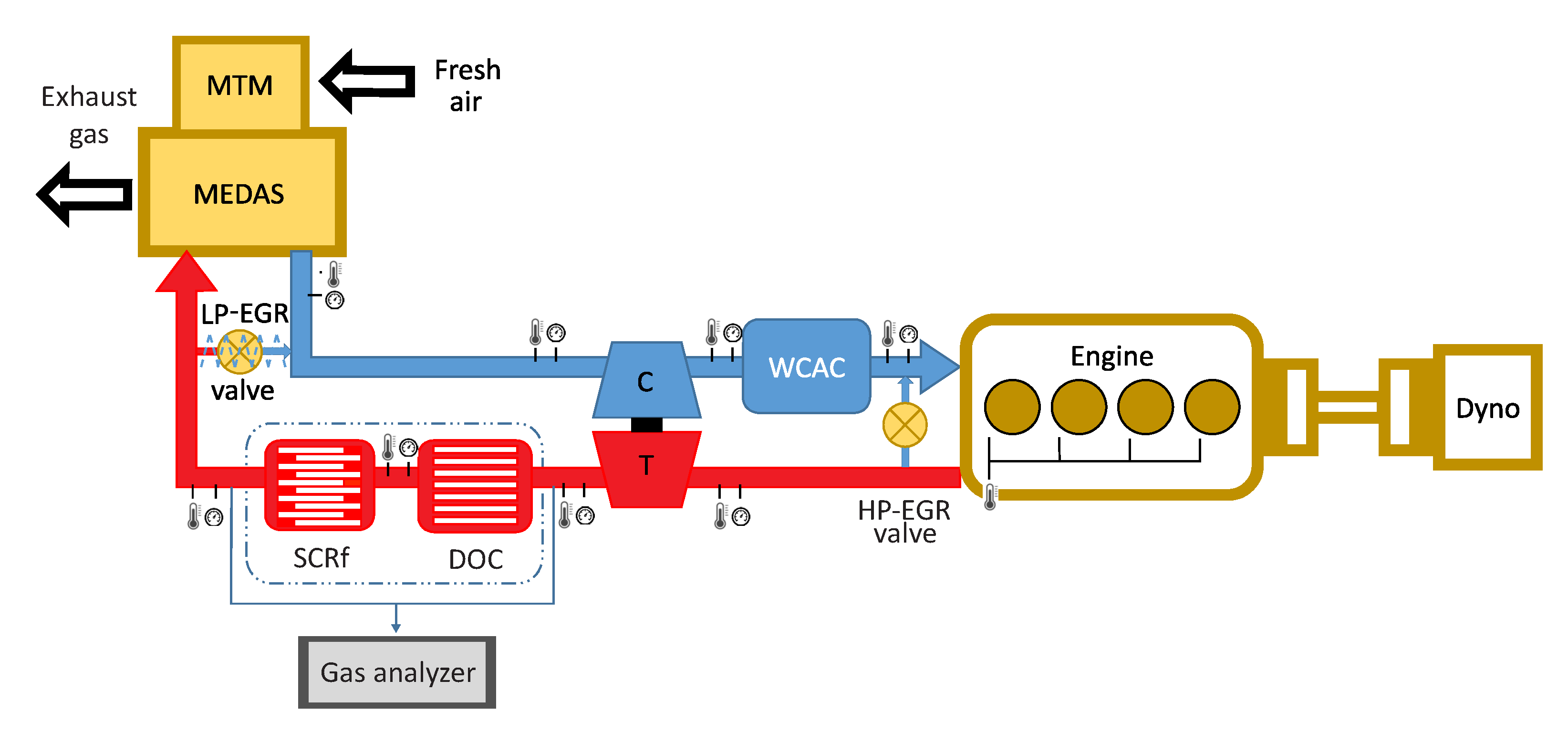
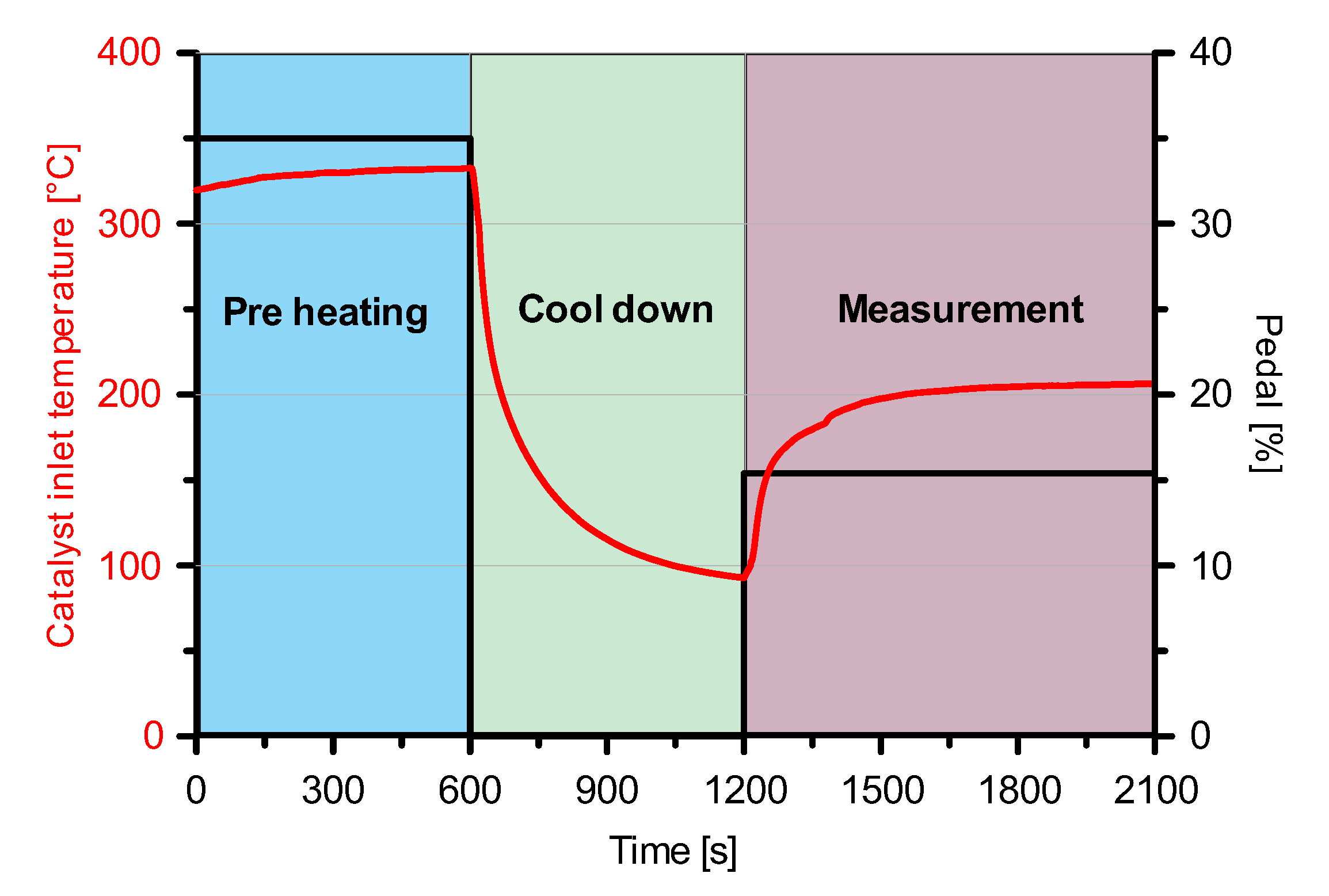
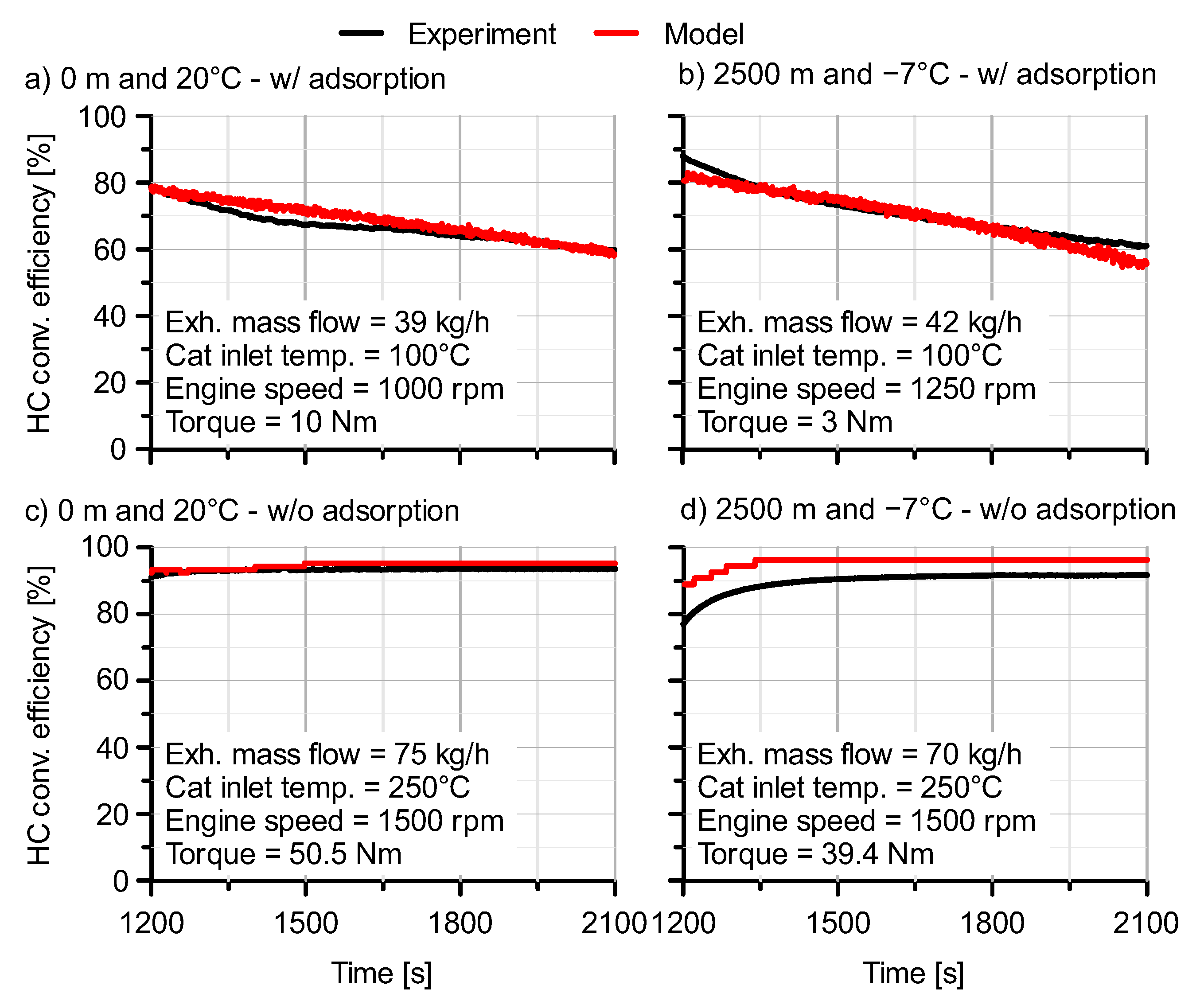
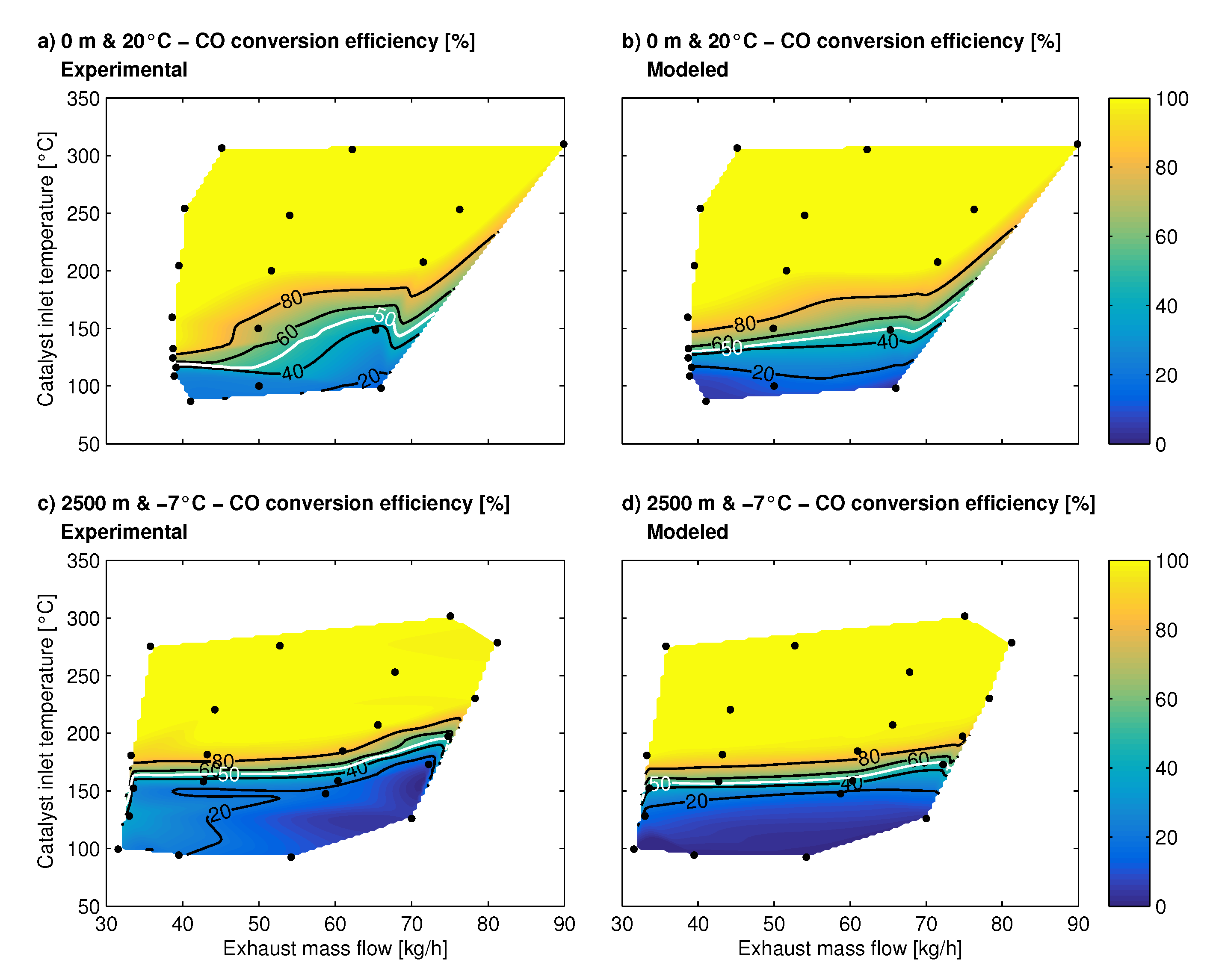
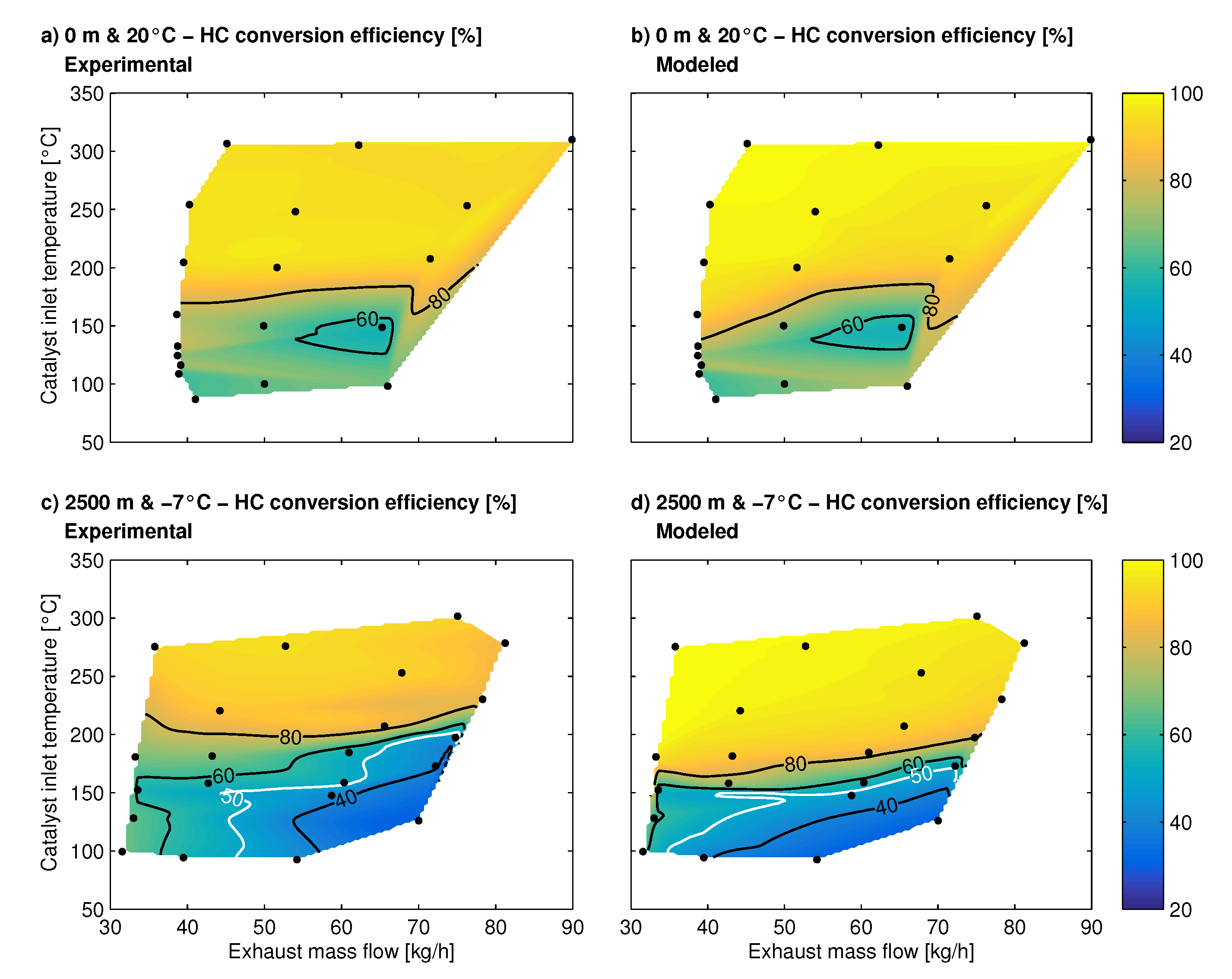

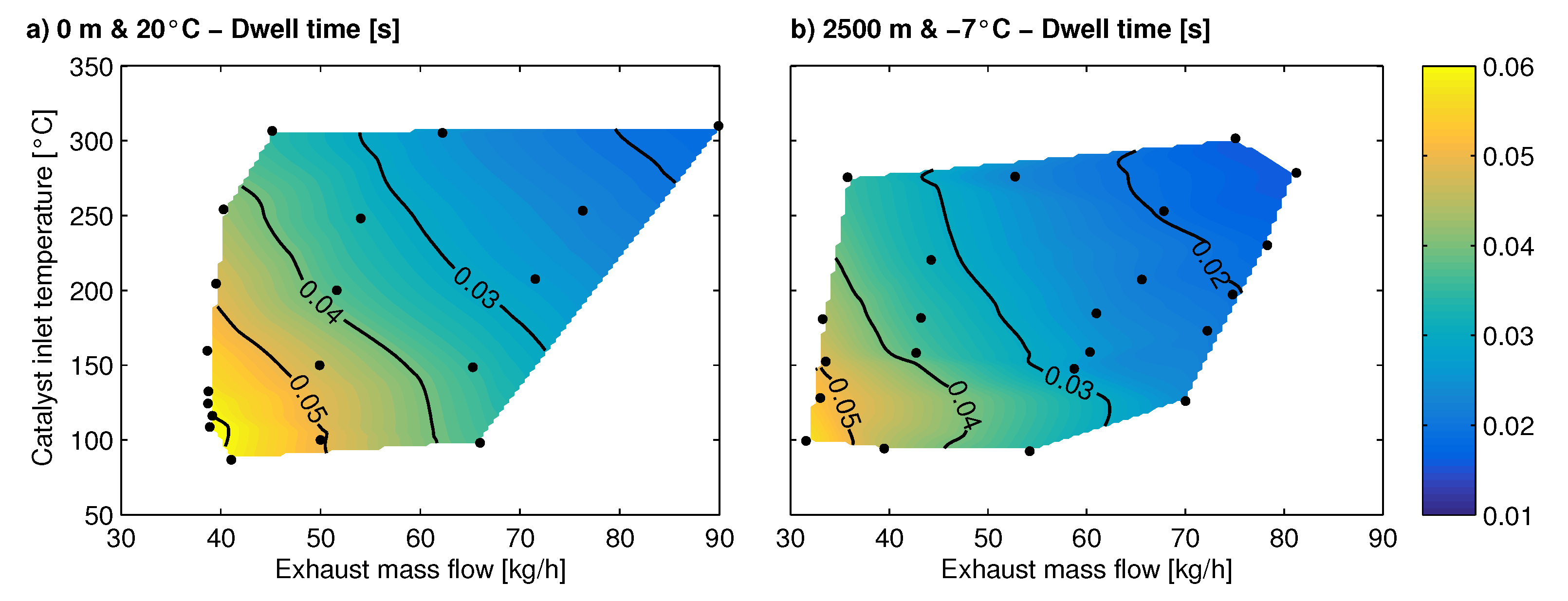

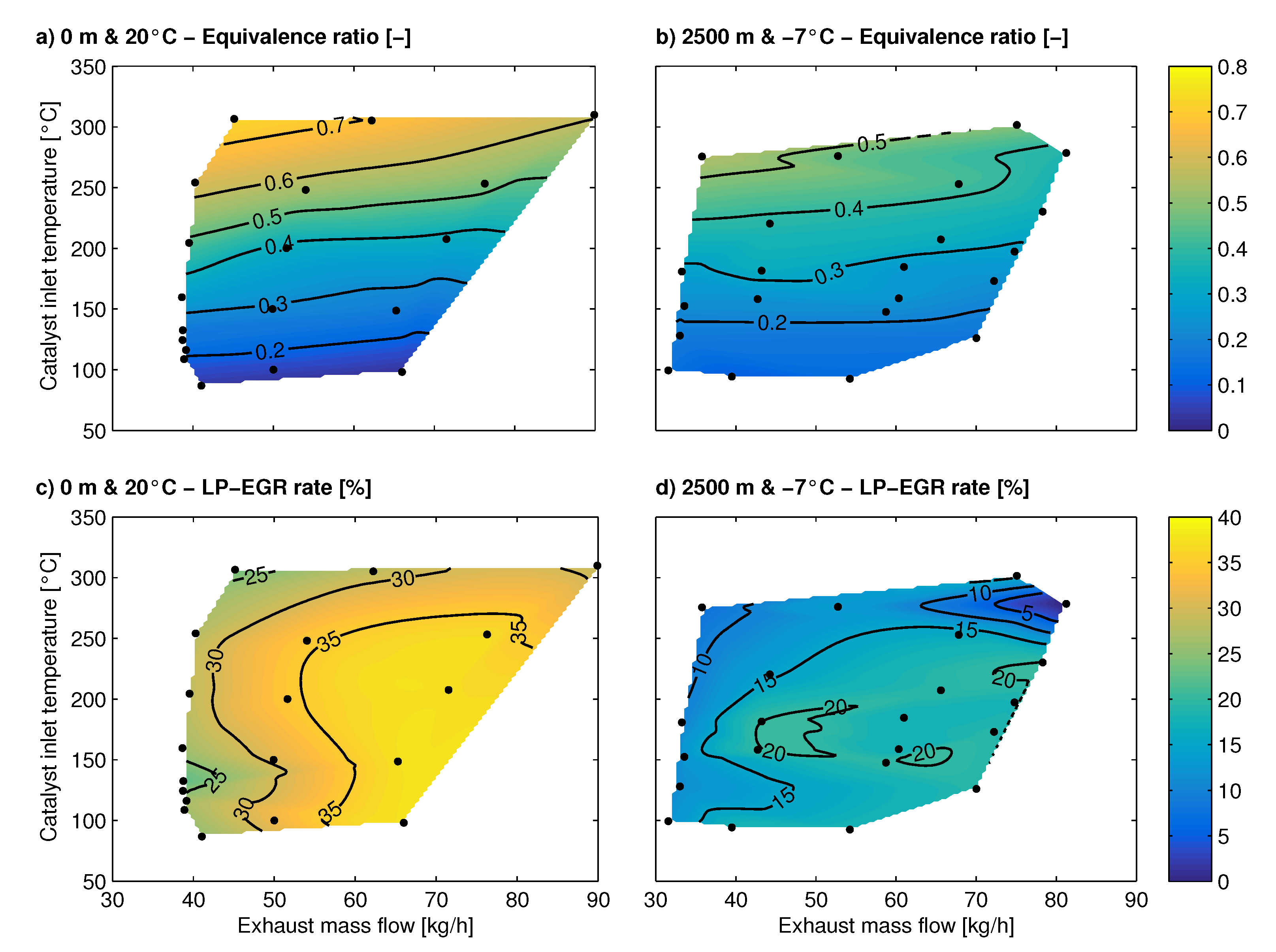



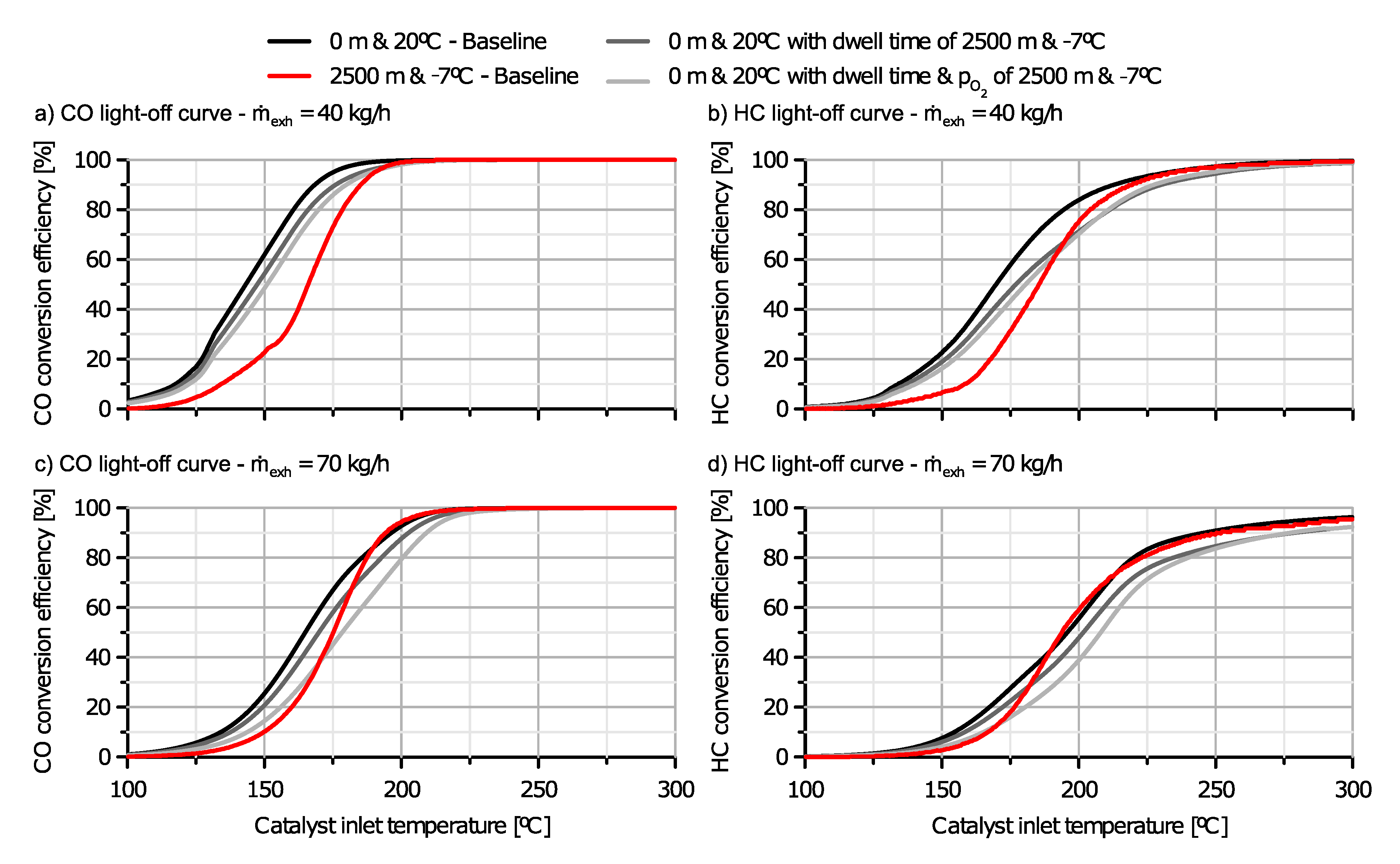
| Reference | Engine | Legislation | Operating Conditions | Contribution |
|---|---|---|---|---|
| Luján et al. [6] | Diesel 1.6 L | Euro 5 | 0 m & 20 °C; 0 m & −7 °C | WLTC. Higher engine-out emissions at −7° than at 20 °C along with decrease of DOC conversion efficiency. |
| Ko et al. [7] | Diesel 2.2 L | Euro 6 | 0 m & 23 °C, 14 °C and 5 °C | NEDC and WLTC. Higher NOx and CO emissions at low ambient temperature. |
| Bermúdez et al. [12] | Diesel 2.0 L | Euro 4 | 150 m to 3000 m & Ambient temperature n/a | NEDC. Increase on CO, HC and NOx emissions with altitude. |
| Ramos et al. [13] | Diesel 2.0 L; Biodiesel 2.0 L; GTL 2.0 L. | Euro 4 | 0 m to 2500 m, ambient temperature n/a | WLTP + RDE-LDV test. At high altitude NOx emissions were higher. Effect of fuels agrees with cetane number. |
| Wang et al. [14] | Diesel 2.8 L | Chinese National III | 1000 m & 25 °C; 2400 m & 27 °C; 3200 m & 19 °C | RDE test. Increase of CO, HC and PM with altitude. Higher NOx emissions at 2400 m than at 1000 m, but lower at 3200 m. |
| Wang et al. [15] | Diesel 2.0 L | China IV | 30 m to 2990 m & 20 °C to 33 °C | RDE test under regulation requirements (1200 m/100 km). Higher CO and PN emissions in altitude but lower NOx. |
| Giraldo et al. [16] | Diesel 10.8 L | US EPA 2004 | 2200 m to 3313 m & 20 °C | RDE test w/o catalytic converter. Values for CO higher than allowed by the legislation. |
| McCaffery et al. [17] | GDI 2017 2.0 L; GDI 2017 1.5 L; GDI 2018 3.6 L | Tier 3 | 0 m to 1524 m, ambient temperature n/a | RDE test. Higher PM emissions in altitude. PM reduction by adding catalyzed GPF. |
| Current work | Diesel 1.6 L | Euro 6d-Temp | 0 m & 20 °C; 2500 m & −7 °C | Steady-state conditions. Reduction of CO and HC conversion efficiencies at 2500 m and −7 °C and increase of the light-off temperature. |
| Engine type | HSDI diesel |
| Emissions Standards | Euro 6d-Temp |
| Number of cylinders | 4 in line |
| Displaced volume [] | 1461 |
| Bore [mm] | 76 |
| Stroke [mm] | 80.5 |
| Number of valves | 2 per cylinder |
| Compression ratio | 15.2:1 |
| Rated power @ speed | 81 kW @ 4000 rpm |
| Rated torque @ speed | 260 Nm @ 1750–2500 rpm |
| Fuel Injection | Common-rail direct injection |
| Turbocharger | VGT |
| EGR | HP- and cooled LP-EGR |
| ATS | Closed-coupled DOC + SCRf |
| Substrate | Cordierite |
| Washcoat | Alumina oxide and -zeolite |
| Coating | Pt |
| Monolith length [mm] | 140 |
| Monolith diameter [mm] | 120 |
| Channel cross-section | Square |
| Cell density [cpsi] | 400 |
| Cell size [mm] | 1.04 |
| Wall thickness [mm] | 0.23 |
| Catalytic area [] | 3.95 |
| Kinetic Constants | ||
| HC adsorption | 0 | |
| HC desorption | 110,000 | |
| HC oxidation | 85,000 | |
| CO oxidation | 80,000 | |
| Inhibition Terms | ||
| 455 | −7990 | |
| 2.98 | −96,534 | |
| 31,036 | ||
| Point | Condition | Temp. [°C] | Mass Flow [kg/h] | CO eff. [%] | HC ox. eff. [%] | HC ads. eff. [%] | Total HC eff. [%] |
|---|---|---|---|---|---|---|---|
| A | 0 m & 20 °C | 98.17 | 66.00 | 1.09 | 0.00 | 68.83 | 68.83 |
| B | 0 m & 20 °C | 124.40 | 38.72 | 32.25 | 5.22 | 62.60 | 67.82 |
| C | 0 m & 20 °C | 159.61 | 38.64 | 93.89 | 79.44 | 11.35 | 90.79 |
| D | 0 m & 20 °C | 253.22 | 76.29 | 100.00 | 89.52 | 0.00 | 89.52 |
| E | 2500 m & −7 °C | 92.53 | 54.22 | 0.17 | 0.00 | 37.41 | 37.41 |
| F | 2500 m & −7 °C | 128.13 | 33.02 | 14.64 | 3.45 | 58.62 | 62.07 |
| G | 2500 m & −7 °C | 158.78 | 60.33 | 44.27 | 12.35 | 18.52 | 30.87 |
| H | 2500 m & −7 °C | 230.25 | 78.31 | 99.19 | 78.33 | 0.00 | 78.33 |
Publisher’s Note: MDPI stays neutral with regard to jurisdictional claims in published maps and institutional affiliations. |
© 2021 by the authors. Licensee MDPI, Basel, Switzerland. This article is an open access article distributed under the terms and conditions of the Creative Commons Attribution (CC BY) license (http://creativecommons.org/licenses/by/4.0/).
Share and Cite
Serrano, J.R.; Piqueras, P.; Sanchis, E.J.; Diesel, B. Analysis of the Driving Altitude and Ambient Temperature Impact on the Conversion Efficiency of Oxidation Catalysts. Appl. Sci. 2021, 11, 1283. https://doi.org/10.3390/app11031283
Serrano JR, Piqueras P, Sanchis EJ, Diesel B. Analysis of the Driving Altitude and Ambient Temperature Impact on the Conversion Efficiency of Oxidation Catalysts. Applied Sciences. 2021; 11(3):1283. https://doi.org/10.3390/app11031283
Chicago/Turabian StyleSerrano, José Ramón, Pedro Piqueras, Enrique José Sanchis, and Bárbara Diesel. 2021. "Analysis of the Driving Altitude and Ambient Temperature Impact on the Conversion Efficiency of Oxidation Catalysts" Applied Sciences 11, no. 3: 1283. https://doi.org/10.3390/app11031283
APA StyleSerrano, J. R., Piqueras, P., Sanchis, E. J., & Diesel, B. (2021). Analysis of the Driving Altitude and Ambient Temperature Impact on the Conversion Efficiency of Oxidation Catalysts. Applied Sciences, 11(3), 1283. https://doi.org/10.3390/app11031283








